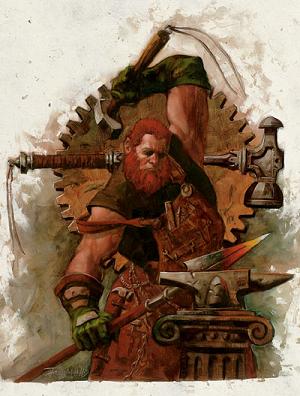Gond

| |
| Gond | |
|---|---|
| Titles | Lord of All Smiths, Wonderbringer, Zionil |
| Symbol | A toothed metal, bone, or wood cog with four spokes |
| Home Plane | House of Knowledge |
| Alignment | True Neutral |
| Portfolio | Artifice, Construction, Craft, Smithwork |
| Worshipers | Blacksmiths, crafters, engineers, gnomes, inventors, Lantanese, and woodworkers |
| Domains | Craft, Earth, Fire, Knowledge, Metal, Planning |
| Favored Weapon | Warhammer |

|
Neverwinter Nights 2 Wiki Visit related material |

|
Forgotten Realms Wiki Visit related material. |
Gond (pronounced GAHND), the Lord of All Smiths, was a intermediate deity of craft and smithwork, whose faith was the state religion of Lantan. The church of Gond was tolerated across Faerûn and members were found in both good- and evil-aligned human populations. He had an increasing following in rock gnome communities. In Durpar, Estagund, and Var the Golden, he was known as Zionil, patron of craftfolk, inventors and creators.
Gond was accepted among the gnomish pantheon as Nebelun the meddler, though a small gnomish cult believed that Nebelun was a separate deity.
Relations
Along with Milil, Deneir, and Oghma, Gond was one of the Deities of Knowledge and Invention.
Clergy and Temples
Temples to Gond were imposing, boxy stone structures surrounded by porticoes. The only internal decorations were sprawling exhibits of items, some of historical interest, some representing the latest work of master crafters. The central altar consisted of a massive anvil surrounded by spinning cogs in a giant machine. Backrooms consisted of workshops.
Clerics of Gond had a unique dress. They wore saffron robes, sashes that held tools, and sun hats. They had great belts of large linked medallion ringlets. In north Faerûn, they served rural communities as tinkerers, carpenters, and civil engineers. All clerics of Gond kept a journal in which they wrote down ideas for inventions to be worked on and contemplated. Journals kept by wandering priests were given to temples they visited. Their notes were recorded and added to the temple library for everyone to gain insight from.
The center of Gondite religion was the High House of Wonders in Baldur's Gate. The cities' faithful also built a great museum, the Hall of Wonders, to display Gondite inventions.
| Deities | |
|---|---|
| Overgods | |
| Major | |
| Minor | |
| Drow | |
| Dwarven | |
| Elven | |
| Gnomish | |
| Halfling | |
| Mulhorandi | |
| Orcish | |